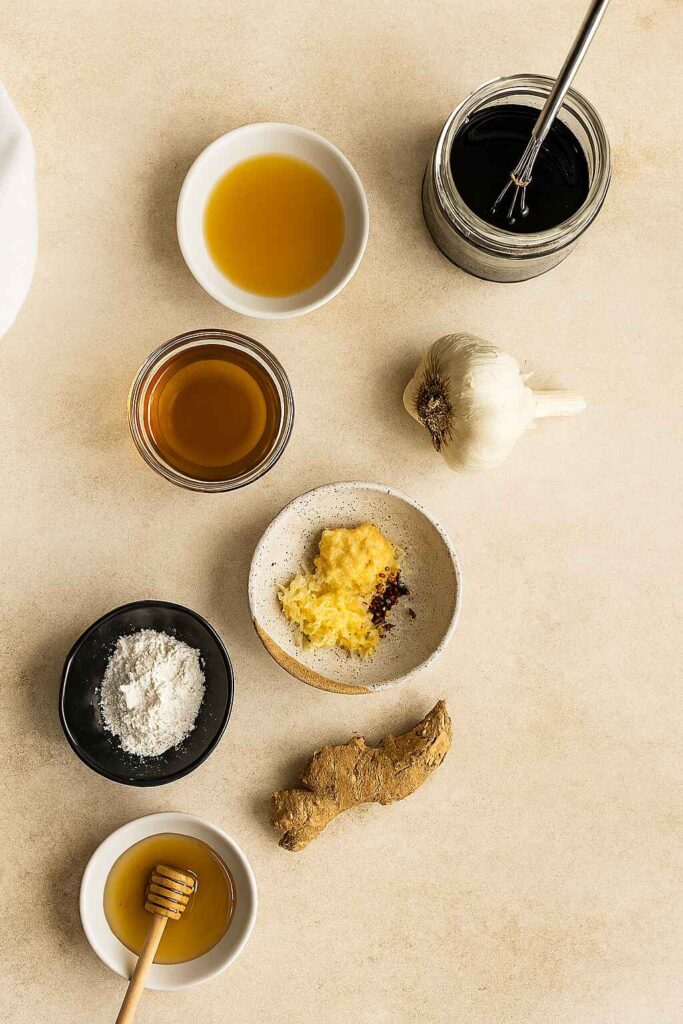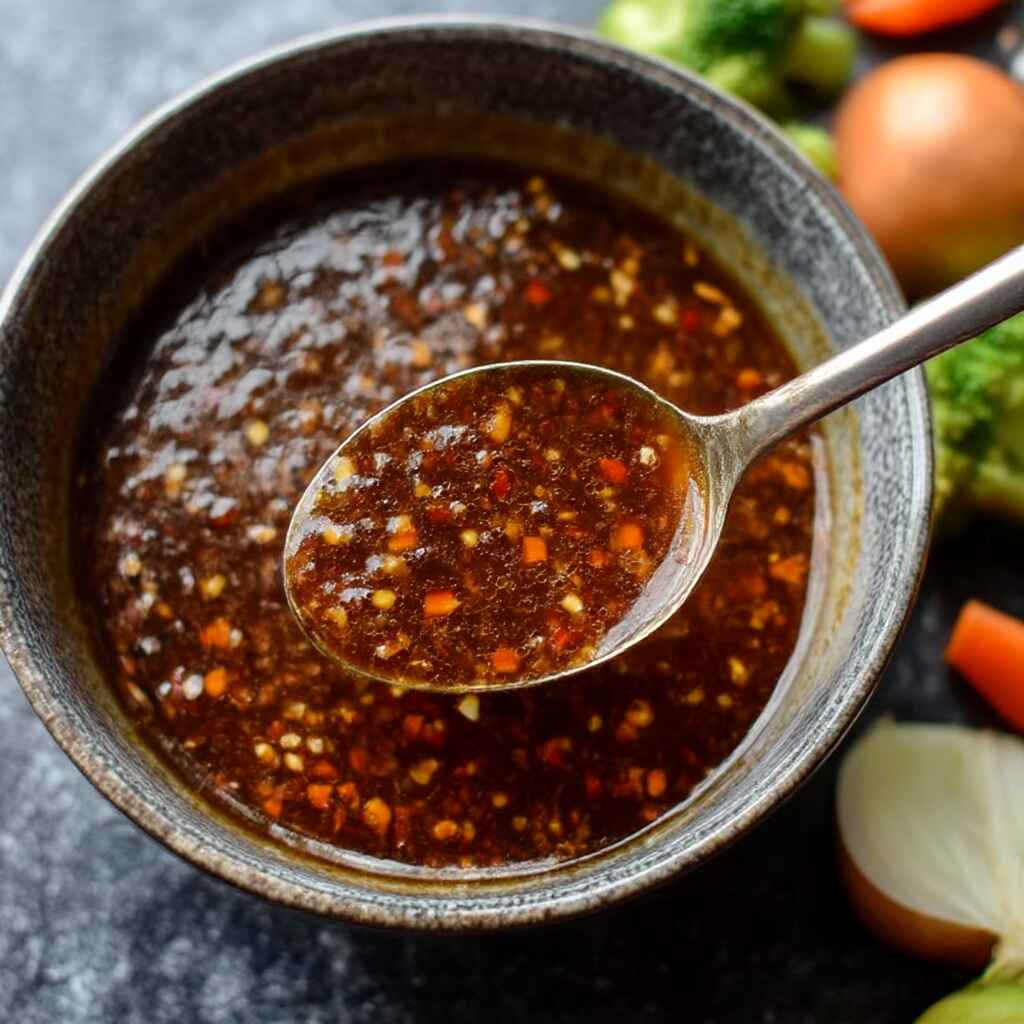Looking to make your stir fry dishes pop with bold flavor? This article walks you through everything about making the perfect stir fry sauce from my family’s trusted recipe to pro-level secrets. Whether you want a quick sauce for weeknights, a healthy low-sodium version, or something that tastes just like your favorite takeout, I’ve got you covered. We’ll talk technique, variations like teriyaki vs stir fry sauce, and how to avoid bland results. Let’s bring your stir fry game to a whole new level packed with flavor, not frustration.
Stir Fry Sauce From My Golden Kitchen
A Story of Flavor, Family, and the Best Stir Fry Sauce
In my golden kitchen, where my story began, stir fry night was always something special. I’d watch my mom swirl soy sauce, vinegar, and ginger into a tiny bowl with effortless grace. Her homemade stir fry sauce wasn’t just tasty it was soulful. Sweet, salty, and rich with garlic, it was the glue that held together weeknight meals and weekend feasts. She called it her “magic mix,” and I believed her.
Now that I have a kitchen of my own, I’ve brought that tradition with me and refined it. Whether I’m working with chicken, shrimp, or just crispy bok choy, my go-to healthy stir fry sauce recipe is bold, fast, and far better than anything from a bottle.
Want something low-sodium? No problem. I simply switch to low sodium soy sauce and skip the sugar. Need it gluten-free? Just use tamari or coconut aminos. And for those watching sugar, I’ve got a sugar free stir fry sauce version that still delivers flavor. You’ll never need to settle again.
If you’re craving dinner inspiration, try this juicy Beef and Broccoli Stir Fry or the slurpy goodness of Chicken Stir Fry with Noodles both recipes pair perfectly with my signature sauce.
Why Make Your Own Stir Fry Sauce?
Making your own gluten free stir fry sauce is not only healthier, it’s empowering. You get total control over salt, sugar, spice and you avoid hidden additives found in store-bought sauces. With a few pantry basics and five minutes, you’ll have something rich, glossy, and customizable to every craving.
It’s a simple trick with powerful results and a delicious way to connect your meals to something real.
How to Make the Perfect Stir Fry Sauce
A Foolproof Stir Fry Sauce Recipe (Customizable & Delicious)
Making the perfect stir fry sauce at home is easier than you think. Start with this basic recipe, and you’ll never go back to store-bought again.
Here’s what you’ll need:
- ¼ cup low sodium soy sauce
- 2 tablespoons rice vinegar
- 1 tablespoon sesame oil
- 1 tablespoon honey or brown sugar
- 1 teaspoon cornstarch (for thickening)
- 1 teaspoon grated fresh ginger
- 1 garlic clove, minced
- Optional: red pepper flakes for heat

Just whisk it all together in a bowl. That’s it. The cornstarch helps create a glossy sauce that clings beautifully to veggies and protein. For meal prep, make a double batch and store in a jar in the fridge for up to 7 days.
If you’re cooking something creamy and comforting like this Creamy Garlic Parmesan Chicken Pasta, this sauce can add a savory twist with an Asian kick.
For shrimp or fish lovers, use it with this spicy, citrus-kissed Easy Spicy Shrimp Tacos to elevate your taco game.
Stir Fry Sauce Variations: Healthy, Keto, Gluten-Free & Sugar-Free
Healthy Stir Fry Sauce Recipe:
Skip added sugars and use coconut aminos in place of soy sauce. Add fresh garlic, ginger, and apple cider vinegar. Use arrowroot instead of cornstarch to keep it clean.
Keto Stir Fry Sauce:
For a true keto stir fry sauce, use tamari or coconut aminos, and swap honey for a sugar-free sweetener like monk fruit or erythritol. Thickening? Use xanthan gum instead of starch.
Gluten Free Stir Fry Sauce:
Tamari or gluten-free soy sauce are perfect substitutes. Pair with naturally gluten-free thickeners like arrowroot or cornstarch.
Sugar Free Stir Fry Sauce:
Use stevia or monk fruit as a sweetener. You’ll still get the richness of a balanced stir fry sauce without the carbs or sugar spike.
These versions don’t just taste amazing they’re designed to support your lifestyle goals, whether you’re managing sodium, sugar, or gluten sensitivity.
Teriyaki vs Stir Fry Sauce & How to Master Flavor
Is Teriyaki Sauce the Same as Stir Fry Sauce?
Not quite though it’s easy to confuse the two. Teriyaki sauce is a specific type of stir fry sauce, but not all stir fry sauces are teriyaki. Teriyaki tends to be thicker and sweeter, often made with soy sauce, sake (or mirin), and sugar. It’s ideal for glazing grilled meats or fish.
On the other hand, a classic stir fry sauce is more versatile and balanced less sweet and more adaptable. You can adjust it for heat, acidity, or richness depending on the protein or veggies you’re using. If you’re after variety, the traditional stir fry sauce is your best friend.
Looking to try both? My Beef and Pepper Rice Bowl tastes incredible with a rich soy-based stir fry sauce, while teriyaki adds that glossy, sweet finish on grilled chicken.
How to Thicken Stir Fry Sauce Like a Pro
A thin sauce will run right off your food and nobody wants a watery stir fry. The trick? Cornstarch slurry. Simply mix 1 teaspoon of cornstarch with 2 teaspoons of cold water, then add it to your sauce while cooking. It thickens almost instantly once the pan heats up.
Want a healthier option? Use arrowroot powder or, for a keto stir fry sauce, go with xanthan gum it thickens beautifully with just a pinch and keeps carbs in check.
Avoid clumps by whisking your slurry before adding it, and always cook the sauce a bit longer to activate the starch. That silky, glossy finish you love in takeout? This is how you get it.
And if you’re out of time, the best store bought stir fry sauce options include clean-label brands like Primal Kitchen (great for gluten free stir fry sauce) or Kikkoman’s low-sodium blend. But honestly? Nothing beats homemade.
For more flavor-packed ideas, try your sauce over this cozy Broccoli Cheese Soup or add a drizzle to a rice bowl for quick weeknight flair.
Stir Fry Flavor Fixes & Secret Ingredients
Why Does My Stir Fry Taste Bland?
If your stir fry turns out flat or flavorless, it’s usually because one key element is missing balance. A proper stir fry sauce should hit sweet, salty, acidic, and umami notes all at once.
Here are a few culprits to check:
- No acid? Add a splash of rice vinegar or lime juice.
- Missing umami? Use soy sauce, fish sauce, or even a dab of miso.
- Too watery? You likely skipped the thickener or added the sauce too early.
- Overcrowding the pan? That steams your food use high heat and cook in small batches.
Your sauce is everything. If it’s not working, chances are you need to tweak just one element more sweetness (honey, brown sugar), depth (garlic, ginger), or heat (chili flakes, sriracha).
What’s the Secret Ingredient in Chinese Stir Fry?
the “secret” behind that bold, restaurant-style Chinese stir fry flavor isn’t just the sauce — it’s the layering of umami-rich ingredients and the power of high heat.
If you want that same deep, satisfying flavor at home — without alcohol or additives try this combination instead:
- A spoon of oyster sauce for savory richness
- A dash of toasted sesame oil, added at the end for maximum aroma
- A splash of rice vinegar mixed with a bit of soy sauce or apple juice for that restaurant-style tang
- Always use fresh garlic and ginger they’re non-negotiable flavor builders
Marinate your protein in soy sauce, cornstarch, and garlic like in this Greek Chicken Marinade, then cook it hot and fast. Finish with a bold, thickened sauce and watch how your stir fry transforms from bland to addictive.
Pair with simple sides or your favorite dip, like this High Protein Crack Dip Recipe for a high-energy weeknight dinner spread.
FAQs Section
How do you make stir fry taste like a restaurant?
Use high heat, don’t overcrowd the pan, and add your stir fry sauce near the end to preserve flavor. Include ingredients like oyster sauce or Shaoxing wine for authenticity.
Is stir fry just soy sauce?
No. Soy sauce is the base, but stir fry sauce includes sweeteners, acids, aromatics, and sometimes thickeners for balance and texture.
Is teriyaki and stir fry sauce the same thing?
No. Teriyaki is sweeter, thicker, and meant for glazing. Stir fry sauce is lighter and more balanced for pan-frying with veggies and protein.
What is the secret ingredient in Chinese stir fry?
Shaoxing wine is often the “secret” flavor booster. Others include sesame oil, white pepper, and oyster sauce.
Why does my stir fry taste bland?
Usually it’s from low heat, too much liquid, or unbalanced sauce. Brighten it with vinegar or citrus and finish with sesame oil.
Conclusion: Stir Fry Sauce That Fits Every Kitchen
A great stir fry starts with the right sauce. Whether you’re cooking for picky eaters, eating clean, or chasing that bold restaurant flavor at home, this stir fry sauce can be your secret weapon. It’s fast, customizable, and full of the balanced flavors that turn everyday ingredients into something special.
From the hum of my mother’s kitchen to the sizzling of my own skillet, this sauce has been part of my story. Now it can be part of yours. Whip it up once, and you’ll never go back to bottled.

Stir Fry Sauce Recipe
Ingredients
Method
- In a small bowl, combine soy sauce, rice vinegar, brown sugar, garlic, and ginger.
- Whisk in cornstarch until smooth
- Add water and whisk again.
- Heat gently in a pan or pour directly into stir fry near the end.
- Finish with sesame oil and stir.
